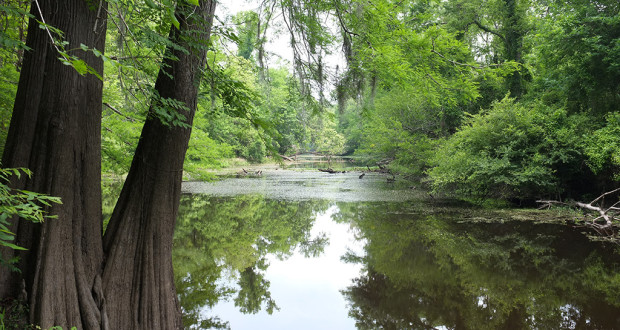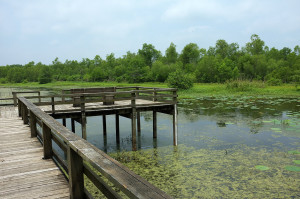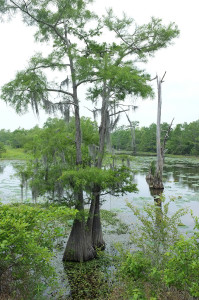More than 15 miles of trails wander through the refuge’s 25,000 acres of bottomland hardwood forest, small lakes, sloughs and marshland. They are generally unmarked and primitive – overgrown with tall grasses and sometimes muddy – but that is part of their charm.
The refuge’s diverse ecosystem hosts hundreds of migratory waterfowl and neotropical birds, in addition to its more permanent residents. More than 100 species breed in the area. The U.S. Fish and Wildlife Service describes the opportunities for birdwatching:
Birding on the refuge is most interesting during the winter months. Fourteen species of sparrows winter on the refuge and fifteen species of wading birds nest here. Birdwatchers are treated to a spectacular variety of more than 50 migrants, including 25 warbler species during the spring and fall migration. During a “fallout”, which typically occurs after a rainy cold front, lucky birders may view dozens of species of neotropical migrants.
The bottomland hardwood forest’s diverse inhabitants are cataloged in refuge’s guides to its flora and fauna: Birds, Butterflies, Fish, Mammals, Plants, Reptiles and Amphibians
Because the forest is primitive, you need to be careful where you step, especially off the trails. There are venomous snakes, alligators and myriad patches of poison ivy.
Of the eight areas of public access on the refuge – Boar’s Den, Brierwood, Butler, Champion Lake, Hirsch, McGuire, Page and Silver Lake – Champion Lake offers the greatest variety of wildlife viewing, including more than 100 bird species, snakes, frogs, turtles, alligators, white-tailed deer, coyotes, raccoons and, occasionally, a bobcat. A large fishing pier juts out into the lake, and boat ramps slip into both the lake and nearby Picketts Bayou.
A broad trail runs along the levee between the lake and the bayou. A branch of the main trail just past the gate leads to numerous informal trails through the forest blazed by fishermen heading for the water. If you keep walking, the trail on the levee narrows and eventually winds its way quite a distance to the Trinity River.
Brierwood offers two primitive loop trails – a short one of 0.5 mile and a longer 6.2-mile loop that cuts deeper into the forest. Both follow along the tail of what is generously called Gaylor Lake, though at that point it is more of a small slough.
REFUGE GALLERY










